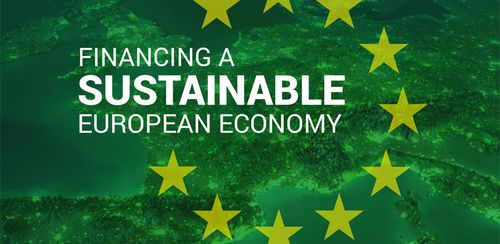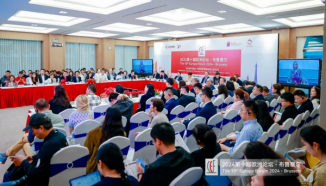The CCCEU Weekly Update Aug 18, 2023: Green--the symbol of life, the background color of nature. The development and governance of the green economy has aroused new attention from the international industry and academia

Editor's Note: Green symbolizes life and is the backdrop of nature. A sound ecological environment forms the foundation of a beautiful life and is the shared aspiration of the people. Green development is a mode that aligns with nature and promotes the harmonious coexistence of humans and the environment. It aims to achieve the maximum economic and social benefits with minimal resource and environmental costs. It signifies high-quality and sustainable development, and has become a consensus among international community. The European Union's statistical agency, Eurostat, headquartered in Luxembourg, reported on Wednesday, August 16th, that the overall economy of the EU grew by 1.2% year-on-year in the first quarter of 2023, while the EU's greenhouse gas emissions decreased by nearly 3% compared to a year ago. This edition of the CCCEU Weekly Update keeps you informed of China-EU dynamics. Enjoy reading and have a nice weekend.
▶︎ Focus
The green economy emphasizes the coordination between economic activities and ecosystems, aiming for efficient resource utilization and the reduction of pollution and environmental degradation. Green economy aims to provide people with a better quality of life while reducing ecological footprints and ensuring the sustainability for future generations. Eurostat, headquartered in Luxembourg, reported on Wednesday, August 16th, that the EU's overall economy grew by 1.2% year-on-year in the first quarter of 2023, but the EU's greenhouse gas emissions decreased by nearly 3% compared to a year ago. Reuters reported that the EU's first-quarter carbon dioxide equivalent emissions were equivalent to 941 million metric tons, down 2.9% year-on-year.
As the world faces increasingly unpredictable extreme climate events, including heatwaves in countries like Portugal and Spain, the EU is actively pushing to achieve net-zero emissions by 2050. Among the 27 EU member states, emissions decreased in 21 countries, with the largest reductions observed in Bulgaria, Estonia, and Slovenia. However, countries like Ireland, Latvia, Denmark, Sweden, and Finland saw an increase in gas emissions. According to Eurostat, households accounted for nearly a quarter of the overall gas emissions, while the manufacturing sector accounted for one-fifth.
The Academy of Management Annual Meeting 2023, held from August 4th to 8th in Boston, USA, is the largest and most comprehensive conference in the field of management academia. Shandong University and KU Leuven jointly cultivated doctoral student, Ms Chen Che, an invited contributor from the Chinese Chamber of Commerce to the EU, attended the conference. The conference themes reflect the high level of attention given by the academic community to topics such as green economy and corporate social responsibility. Green economy is a development model that is based on sustainable development, aiming to achieve economic growth, social progress, and environmental protection through promoting ecological balance and environmental protection.
Importance of Green Economy:
1.Sustainability: Green economy promotes economic sustainability, ensuring the long-term availability of resources.
2.Environmental Protection: It emphasizes ecological balance, promoting the reduction of pollution, waste, and environmental degradation, thereby preserving the natural environment.
3.Innovation and Competitiveness: Green economy encourages innovation, fosters the development of environmentally friendly technologies and sustainable industries, enhancing corporate competitiveness.
4.Brand Value: Adopting environmental measures can enhance brand value, gaining recognition from consumers, investors, and society.
5.Risk Management: Reduces environmental and legal risks, minimizing negative impacts caused by environmental issues.
Recommendations for Enterprises in Green Economic Development and Governance:
1.Sustainable Strategies: Develop and implement strategies that are guided by sustainable development, integrating environmental considerations into core business decisions.
2.Efficient Resource Utilization: Optimize resource usage, reduce energy consumption and material waste, promote green production and operations.
3.Innovative Research and Development: Invest in research and development of green technologies, drive innovation in clean energy, recycling, and other areas.
4.Supply Chain Management: Encourage suppliers to comply with green standards, facilitate the transition to a green supply chain.
5.Adherence to Environmental Standards: Comply with environmental regulations and standards, ensure that production processes and products meet environmental requirements.
6.Transparency and Reporting: Provide environmental data and reports, showcasing the environmental impact and improvement measures of the enterprise.
7.Employee Training: Offer employee training to enhance environmental awareness and encourage participation in green initiatives.
8.Social Engagement: Participate in environmental projects to fulfill corporate social responsibility.
9.Collaborative Innovation: Collaborate with other businesses, organizations, and governments to jointly promote green economic development.
In conclusion, green economy is a crucial developmental direction for enterprises, enhancing sustainability and competitiveness. Through the implementation of green economy measures, enterprises can achieve a win-win scenario of economic benefits and environmental protection, ultimately contributing positively to society and the environment.
▶︎ Hot Topics
>>New law on more sustainable, circular and safe batteries enters into force
A new law to ensure that batteries are collected, reused and recycled in Europe is entering into force today. In line with the circularity ambitions of the European Green Deal, the Batteries Regulation is the first piece of European legislation taking a full life-cycle approach in which sourcing, manufacturing, use and recycling are addressed and enshrined in a single law.
>>China to keep halogenated rubber anti-dumping duty until probe is over
China's commerce ministry said on Wednesday that it will continue to impose anti-dumping duties on imports of halogenated rubber originating in the United States, the European Union and Singapore from Sunday.
>>China's State Council issues 24-point guideline to optimize foreign investment
China's State Council, the cabinet, on Sunday issued a 24-point guideline covering six areas, which is intended to improve the climate for foreign investment and attract more funds, the latest move to stabilize second-half economic growth.The guideline pledged to continue China's high-quality opening-up by using the advantages of the nation's super-sized market, attracting and using foreign investment more efficiently, and building a market-oriented, legalized and internationalized business environment.
>>CRRC produced the first CT tram for Portugal
The Tangshan plant produced the first of 18 four-section trams under a 2020 contract for the Portuguese city of Porto. This delivery is the first urban rail contract for CRRC in EU. The manufacturer notes that it took 8 months to create the tram, and it has yet to be tested at the plant before being sent to Portugal.
>>China becomes world's largest ship-owning country
China, measured by gross tonnages, has surpassed Greece to become the world's largest ship-owning country, according to information released by Shanghai-based China Shipowner's Association on Saturday. Citing data from the United Kingdom-based Clarkson Research, China's ship-owning fleet currently has reached a total tonnage of 249.2 million GT, accounting for a market share of 15.9 percent, or about $180 billion in fleet value.
>>Hong Kong primed to help EU firms' entry into Chinese mainland market: HKSAR chief executive
John Lee, chief executive of China's Hong Kong Special Administrative Region (HKSAR), said Thursday that Hong Kong has the advantages that can facilitate the vibrant development of European Union (EU) companies in Hong Kong and their entry into the vast markets of the Chinese mainland and the wider Asian region.
▶︎ What are experts talking about?
Participation of Central and Eastern European Countries in the Belt and Road Initiative for Ten Years: Progress and Prospects
Source: Institute of European Studies, Chinese Academy of Social Sciences
Author: Liu Zuokui
(Deputy Director and Researcher, Institute of European Studies, Chinese Academy of Social Sciences)
Cooperation between Central and Eastern European (CEE) countries and China serves as a crucial platform and conduit for advancing the Belt and Road Initiative. Transforming from historical intermediaries and buffer zones, the CEE countries have evolved into vital connectors for cooperation across the Eurasian continent. China attaches great importance to the pivotal role of CEE countries in promoting Eurasian connectivity. Through active efforts to advance connectivity, China aims to establish the Eurasian Land Bridge Economic Corridor, gradually forming two significant channels: overland, primarily utilizing the China-Europe Railway Express, and maritime, employing a combination of sea and land transport, actively propelling the construction of the China-Europe Land-Sea Express.
The prospects for China-CEE cooperation are promising, evidenced by the construction and completion of projects like the Port of Piraeus, the Hungary-Serbia Railway, and the Pelješac Bridge. European Union institutions and leaders from European countries have visited China, seeking opportunities to strengthen cooperation, which vividly illustrates that cooperation between China and Europe is far greater than competition. Enhancing communication and collaboration can greatly lead to mutual benefits. As long as China remains committed to depoliticizing the initiative and promoting pragmatic cooperation, there is substantial untapped potential in this partnership. By solidifying practical cooperation and fostering people-to-people connections, the advancement of the Belt and Road cooperation can be further ensured and carried forward steadily.
Building UK-EU Bridges: Convergent China Policies?
Source: Centre for European Reform
Author: Ian Bond
(Director of foreign policy at the Centre for European Reform)
Both British and EU officials say privately that their views on China are very similar, and that they have more differences with the US than with each other. That is not to say that either London or Brussels would position themselves as equidistant between Beijing and Washington in the event of a confrontation over Taiwan. But both the EU and the UK are more concerned about China's behaviour than about its power as such, and both worry that US efforts to limit China's access to Western technology will divide global markets and damage the world economy.
The UK will never be able to have the same influence over the EU's China policy that it had as an EU member, but both sides stand to gain from an effort to align their separate efforts to pursue their very similar goals. They would then be able to respond more effectively to unacceptable Chinese behaviour; but they would also be better positioned to stand up to the US when they have to.
END
Please note: the English version of this issue is slightly different from our Chinese one. The views and opinions expressed in this article do not necessarily reflect the official position of the CCCEU.
Our website is: en.ccceu.eu
Our mailing address is: info@ccceu.eu
Call us at: +32 2 592 00 07
China Chamber of Commerce to the EU (CCCEU)

 Login
Login Login
Login CCCEU and Gunnercooke Successfully Host Webinar on CSDDD and FLR Compliance to Guide Chinese Businesses
CCCEU and Gunnercooke Successfully Host Webinar on CSDDD and FLR Compliance to Guide Chinese Businesses Cultivating responsible China-EU business leaders essential to tackling global challenges
Cultivating responsible China-EU business leaders essential to tackling global challenges



